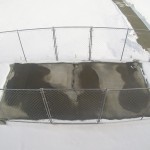 Recently I wrote about a new technology that aims to make our roads safer in winter. The tech is built into the road surface, and as cars drive over it, it releases a layer of salt, which the developers hope will prevent ice from forming on the road.
Recently I wrote about a new technology that aims to make our roads safer in winter. The tech is built into the road surface, and as cars drive over it, it releases a layer of salt, which the developers hope will prevent ice from forming on the road.
The new surface was capable of releasing salt evenly across the road for two months in the lab environment, but the researchers believe it can achieve longer durations in real environments.
A team from the University of Nebraska are aiming to perform a similar trick with a seemingly ordinary slab of concrete.
Smart concrete
The concrete has a small current running through it that is just strong enough to melt any snow or ice that lands on it, whilst remaining safe enough for us to touch.
The researchers have added a mixture of steel shavings and carbon particles to the concrete to allow it to conduct just enough electricity to melt ice and snow.
The material is currently being tested with the Federal Aviation Administration, with plans afoot to install the technology into the tarmac of a major American airport if the tests go well.
“To my surprise, they don’t want to use it for the runways,” the team say. “What they need is the tarmac around the gated areas cleared, because they have so many carts to unload – luggage service, food service, trash service, fuel service – that all need to get into those areas.
“They said that if we can heat that kind of tarmac, then there would be (far fewer) weather-related delays. We’re very optimistic.”
An air of confidence
The team are confident that the tests will go well, as the technology has already proven its worth in other environments. For instance, the 150-foot Roca Spur Bridge was made using the conductive concrete back in 2002, with the 52 slabs successfully keeping the surface ice free during it’s five-year trial period.
“Bridges always freeze up first, because they’re exposed to the elements on top and bottom,” the team say. “It’s not cost-effective to build entire roadways using conductive concrete, but you can use it at certain locations where you always get ice or have potholes.”
Which hints at the potential difficulties of the technology. Whilst the costs involved in de-icing roads or the costs of slower or more dangerous traffic are evident, they are often delayed costs, whereas installing the smart concrete will be very evident and up-front.
This will likely render the technology most useful in the areas of highest risk, whether that’s bridges, driveways or airports.
It’s certainly an interesting indication of how our cities are evolving to become smarter, and with a variety of approaches being tested, it seems inevitable that our roads will soon be ice-free.
Very clever stuff. I suspect the cost will be the main hurdle for this to overcome.
Heated roads are already a thing, it's basically metal rebar put just underneath the surface of the concrete. A lot of railroad stations in the northeast already utilize these types of devices to keep platforms clear in the winter.
Can I get some for my driveway so I don't have to shovel in winter?
Does anyone want to bet that we'll never ever see this? Like ever?
A full scale test of a bridge was conducted in 2002… 14 years ago. So is this in use now and no one knows about it? Was it just kind of silently adopted?
I think cost has always been the main issue with it.
How much voltage/current does it produce per meter? Will people get electrocuted when walking over it?
People wouldn't get electrocuted walking over it because that's not how electricity works.
You see thousands of birds standing on power lines running at 40kV at 100A and you can too, no problems, and not even feel a thing.
It's when you become a conduit to ground that things become bad. In the time it would take the arc fuse to burn out you'd get hit with the power equivalent to (iirc) 20 sticks of TNT.
An application like this would likely be very low voltage and high amperage to produce heat as the material is likely acting like a large resistor. So even shorting this would likely not cause any harm to a human.